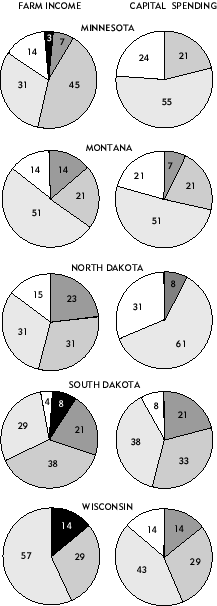"The severe winter weather has caused some death loss for livestock, increased feed costs and fuel costs. This will have a strong negative impact on our farm customers for the next three to six months and perhaps into next year."
—Central South Dakota banker"Severe winter is hard on the livestock producer. This is being offset by the current good prices."
—South-central Minnesota banker
Though severe, winter has not diminished all optimism among Ninth District bankers. The themes of physical and financial stress caused by an extreme winter, coupled with rising optimism for both crop and livestock prices, permeate many of the 95 responses to the quarterly survey of agricultural credit conditions conducted by the Federal Reserve Bank of Minneapolis in late February.
The relative profitability of different outputs noted in the preceding quarter has not changed substantially. Crop prices remain more favorable to producers than livestock prices. Corn and soy prices are generally higher relative to production costs than wheat.
But while this pattern of relative prices shows little change, overall farm prices have risen somewhat. Thus, the general tone of optimism for 1997 with regard to prices contrasts with the disappointment with fall price declines that dominated survey responses in the last quarter of 1996.
Farm income and spending
The optimism for prices in the coming year did not raise the income and spending indicators, which slid somewhat in all district states, but relative positions changed little. Though farm income, household spending and capital spending remained above usual levels in Minnesota, they were still not as high as in the fourth quarter. In hard-hit Montana they also fell and are setting record lows for this decade. Other states fall somewhere in between these extremes.
Farm loan volumes
There have been some changes in loan volumes in the new year. Feeder loans, still below usual levels, have increased moderately over the prior quarter, as have other operating loans and real estate loans. Increases in feeder loans may be due to expectations of improving prices for cattle. Increases in other operating loans are largely due to winter-related fuel and feed expense
Bank credit conditions and liquidity
As was true a quarter earlier, bankers say that they have adequate levels of available funds. Changes in loan-to-deposit ratios vary, dropping from the previous quarter in Minnesota, North Dakota and Wisconsin, and essentially unchanged in Montana and North Dakota. The increase in loan repayment rates reported in the first quarter apparently evaporated, with 46 percent of bankers reporting repayment rates below normal. Bankers attribute slower repayments to the cash flow constraints imposed by the harsh winter.
Bankers apparently continue to tighten collateral requirements. About 25 percent describe such requirements as above usual levels and up from a year ago. This represents an increase of 10 percentage points from the prior quarter.
The proportion of borrowers at their debt limits eased somewhat in Minnesota and the Dakotas and substantially in Montana.
Interest rates and land prices
As has been true for more than a year, interest rates show little change. There is one item of interest: While fixed-rate loan rates stayed the same or increased slightly, four of the five categories of loans showed some decline for variable interest rates. This may not be significant, the majority of responding banks now offer only fixed-rate loans, and the sample of banks with variable-rate loans is thus quite thin.

Minnesota
Minnesota farmers remain in generally good financial conditions, but the difficult winter has hurt them, especially in western areas of the state. Farm income, household spending and capital spending reportedly remain above usual levels, but are down somewhat from the previous quarter. Bankers single out high fuel, feed expenses and poor livestock performance as reasons. Interest in feeder livestock shows a few signs of recovery.
Montana
Some Montana bankers and ranchers reportedly feel that the corner has been turned in livestock prices and that profitability should improve in 1997. That said, estimates of first quarter income and spending hit new lows for the decade. Real estate loan volumes are described as above usual levels and up from a year earlier by a third of bankers. Some comments indicate, though, that this activity is largely restructuring rather than a hot land market. The effects of migrants on Montana agricultural land prices has apparently run its course.
North Dakota
North Dakota farm incomes apparently worsened, continuing a trend noted in the last quarter of 1996. While household spending reportedly shows little change, farmers cinched down on capital spending. Over 60 percent of bankers report such spending as below usual levels. Any enthusiasm about land prices generated by 1996's grain prices has evaporated. Flooding potential for the Red River Valley, North Dakota's richest crop area, is the highest in three decades, and North Dakotans do not seem as optimistic about the 1997 season as their colleagues to the east and south.
South Dakota
South Dakota has had the greatest winter damage relative to the size of its agricultural sector of any district state. That is reflected in bankers' estimates of farm income, which dropped from the preceding quarter. Household spending reportedly remains at usual levels however, and capital spending shows little change from preceding quarter and year-earlier levels. Estimates of year-over-year land price increases declined somewhat from the end of 1996, but proportionately less than in some other states.
Northwestern Wisconsin
As the most dairy-dependent state, Wisconsin was sharply affected by the rapid retreat of milk prices from historic highs posted in the late summer of 1996. Wisconsin thus shows a sharp decline in farm income and spending indicators, though some of the apparent decline may be due to a low response rate this quarter. Bankers also report that loan repayment rates are below year-ago levels, and the proportion of borrowers against their debt limits has increased.





